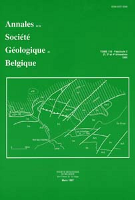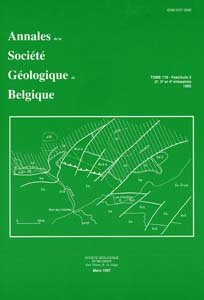- Accueil
- Volume 96 (1973)
- Fascicule 2
- Evolution et paléo-écologie de la vallée de la Petite Nèthe au cours du post-Würm (Belgique)
Visualisation(s): 542 (4 ULiège)
Téléchargement(s): 189 (3 ULiège)
Evolution et paléo-écologie de la vallée de la Petite Nèthe au cours du post-Würm (Belgique)

Abstract
The direct observation of the deposits in a complete section through the valley of the Kleine Nethe (Petite Nèthe, Campine, Belgium) [Chapt. I], completed with many sedimentological analyses (Chapt. II) allows to reconstruct the valley evolution (Chapt. IV). The chronostratigraphy is based on palynological analyses and 14C datations (Chapt. III).
The location of the pollen diagrams in a well defined environment constitutes a favorable element to carry out a paleo-ecological study of the valley (Chapt. V).
Two local geological units are introduced, defined on litho-, chrono- and biostratigraphical basis:
— the member of Vuilvoort: a peat layer mixed with fine alluvium in the valley bottom, is synchronous with a fluviatile stabilisation during the Allerød period. The member of Vuilvoort covers a thin layer of early river deposits.
— the member of Addernesten: an unit of horizontal and subhorizontal layered fluviatile sands, accumulated during the Late Dryas period.
The fluviale dune has also a Late Dryas age.
Palynologically, five different phases can be distinguished during the Allerød period: phase A, increase of Betula; phase B, decrease of Betula in favour of the Cyperaceae and Salix; phase C, second increase of Betula; phase D, second increase of the Cyperaceae; phase E, dominance of Pinus. The first four phases are related to the hydric soil regime.
The comparison of various palynological profiles sampled in the member of Vuilvoort, in relation with the morphology and the nature of the sediments in the valley, permitted a first attempt to reconstruct the diversification of the Late Glacial vegetation.
The Preboreal, characterised by the extension of the Pinus forest is subdivided in four phases. The second phase shows transitory decrease of Pinus in favour of Betula and Gramineae. This phase is synchronized with the Piottino Oscillation in the Alps. During phase 4, the thermophile trees regularly appear.
Local ecological successions have been observed during the Preboreal. They show four stages: aquatic plants abundant; increase of Polystichum thelypteris; extension of Salix; return to more humid conditions.
The first influence of the agriculture observed locally dates from the beginning of the Subatlanticum.






